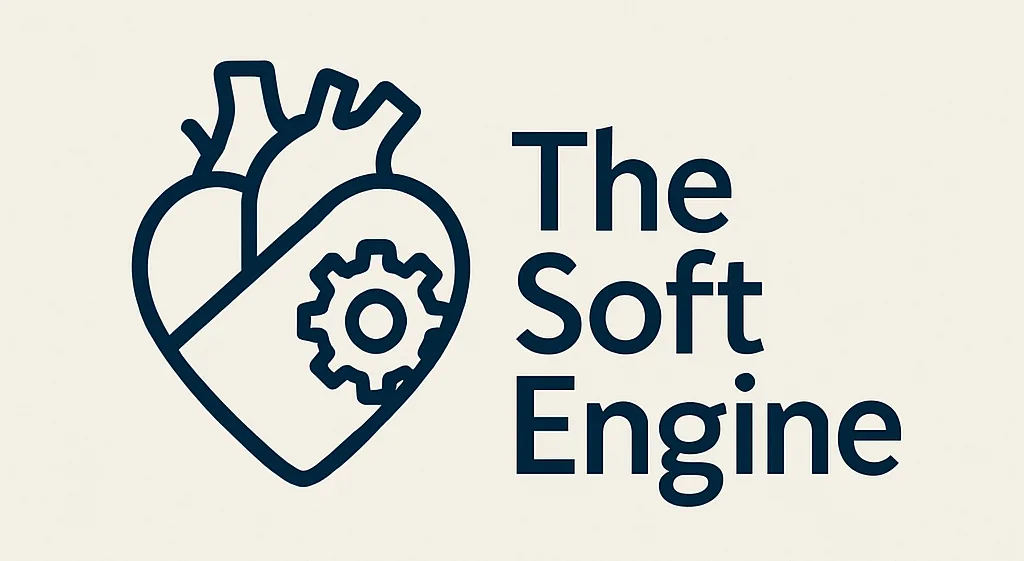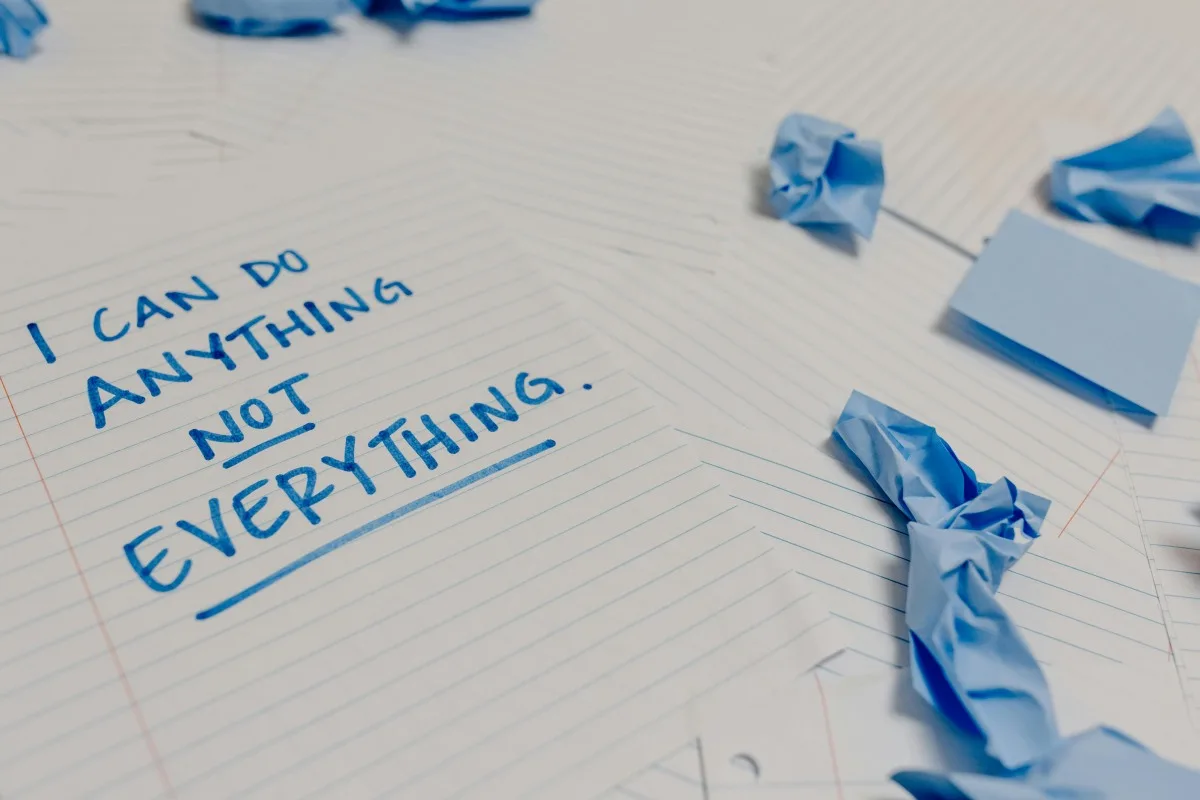Table of Contents
Some days, work flows like water. Other days, you spend an hour toggling between tabs and wonder where the morning went. That tension – between output and distraction – is the heart of productivity.
Productivity isn’t about turning into a superhero with endless willpower. It’s more like learning which parts of your brain are sprinters, which are marathoners, and then giving them the right race.
A few smart levers (time, energy, and attention) can tilt the odds in your favor. Let’s unpack how.
What Is Productivity (In Plain English)
Economists define productivity as “output per unit of input.” That’s tidy math for machines and assembly lines. But humans aren’t factories—we don’t hum at a steady pace, churning out units. We peak, we slump, we get distracted, and sometimes we lose a whole hour to a blinking cursor.
For us, productivity isn’t just squeezing more out of each hour. It’s finishing the work that matters with the energy and attention we actually have. Think of it as progress you can point to at the end of the day: the proposal sent, the draft written, the idea finally tested.
Efficiency is different. It’s about polishing the process: answering emails faster, filing documents cleaner. Useful, sure.
But if none of it moves the needle, you’re just rearranging sugar packets while the lemonade stand sits empty.
ELI5: The Lemonade Stand Analogy
Picture your day like running a lemonade stand. Your lemons are hours, your sugar is energy, and your cups are focus.
Mix them right, and neighbors walk away with lemonade. That’s meaningful work completed.
But here’s the trick: you can spend all afternoon neatly stacking sugar packets, and no one gets a drink.
That’s efficiency without productivity. Real productivity is serving more lemonade (delivering outcomes) without burning through your sugar halfway through the day.
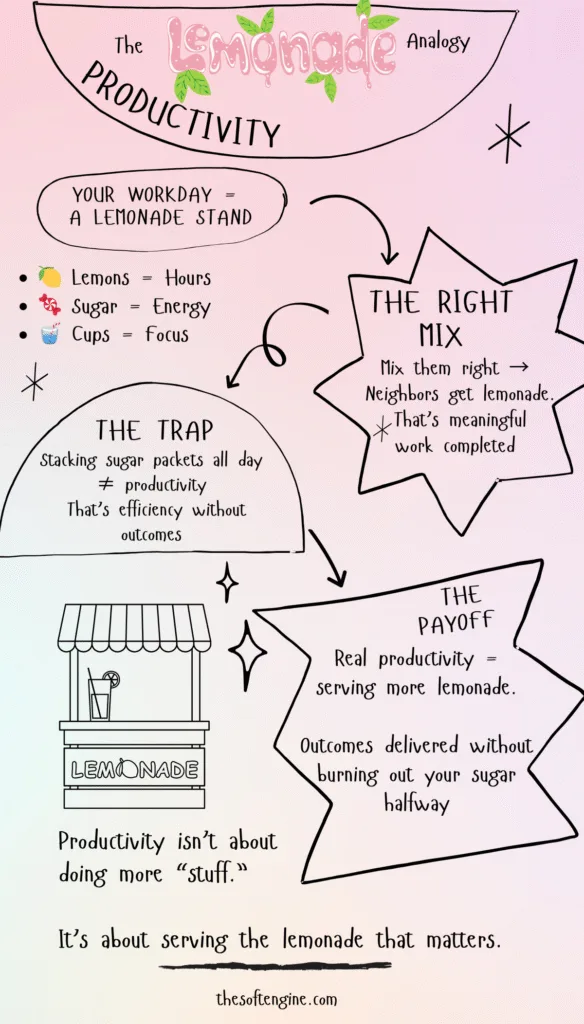
Why Your Brain Fights Productivity
On paper, multitasking sounds efficient: you get more done at once.
In reality, the brain works like a single-lane road. Every time you jump from email to slides to chat, your brain has to slam on the brakes, change lanes, and then accelerate again.
Researchers call this task-switch cost – and it’s measurable in both speed and accuracy.
Studies show that when people juggle, they complete fewer tasks, make more errors, and feel more exhausted than if they’d done the same tasks sequentially.
The hidden tax here is cognitive load. Every unfinished task leaves an “open tab” in your working memory. Stack enough of these, and it feels like having 20 browser windows running on a computer with not enough RAM.
The fan roars, the machine lags, and even simple tasks take longer to complete. That’s why days filled with half-finished efforts leave you drained without much to show for it.
ELI5: The TV Remote Analogy
Imagine watching your favorite cartoon. Just as the story gets good, someone grabs the remote and changes the channel.
Thirty seconds later, they switch again. You never finish an episode – you just keep starting over.
That’s multitasking: lots of motion, no real progress, and a brain too tired to enjoy the show.
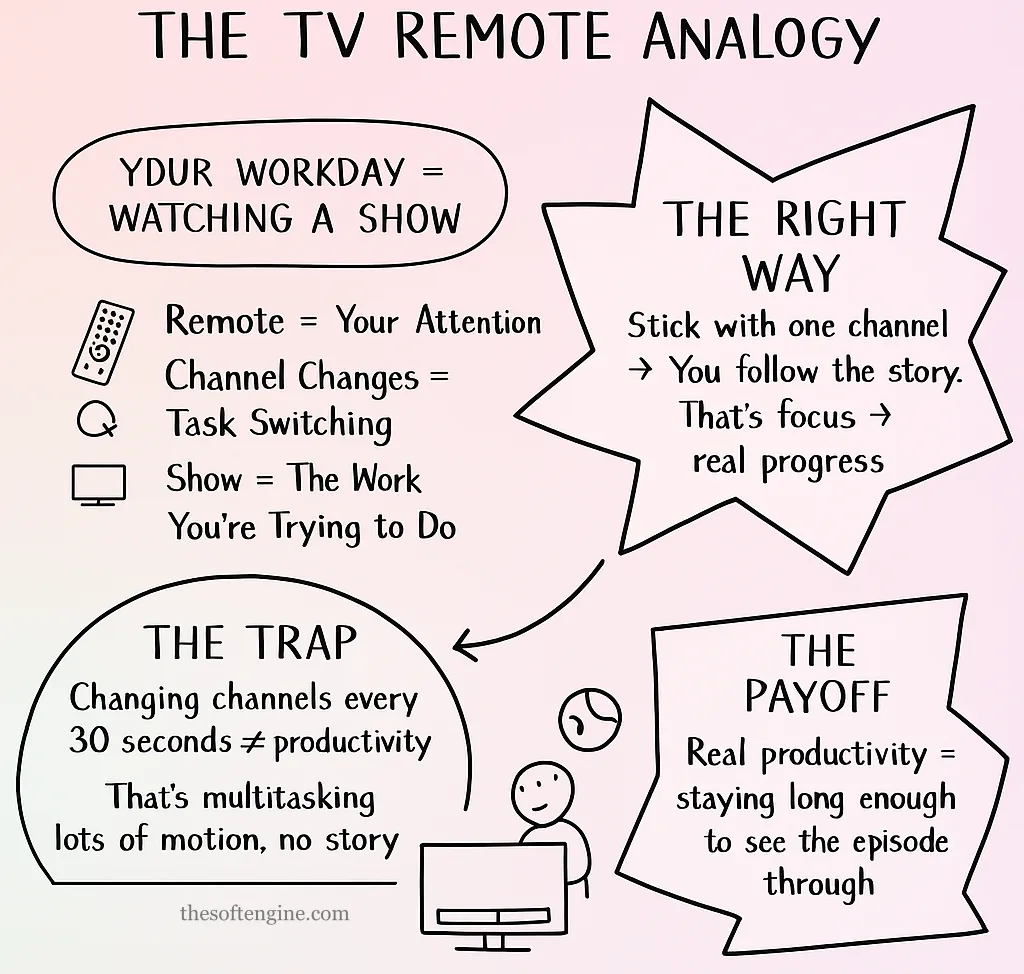
Time, Energy, Attention: The Three Levers You Can Actually Control
Most productivity advice fixates on the calendar – blocking hours, color-coding, scheduling. But time alone is a brittle lever.
If you don’t have the energy to fuel it or the attention to direct it, the best plan collapses by mid-afternoon.
Research backs this up: cognitive performance peaks and dips follow circadian rhythms, not calendars.
Sleep debt doesn’t just make you groggy – it can tank your brain as hard as alcohol. Stanford researchers found that people running on poor sleep performed as badly on reaction-time tests as those with a blood alcohol level of 0.057%.
The CDC reports a similar slide: stay awake for 24 hours and your brain functions like you’re at a 0.10% BAC, which is literally legally drunk in most places.
And attention is just as slippery. Psychologists at Princeton say attention isn’t a steady spotlight but more like a strobe light.
Your brain clicks on, clicks off, about four times a second, which explains why you can be “focused” on a report and still notice the email ping or the fly on the wall. The beam never stays perfectly fixed; it’s always sampling the room.
That means productivity isn’t just “managing hours.” It’s aligning three forces:
- Time → when the work happens.
- Energy → the physical and mental fuel available.
- Attention → the spotlight of focus you can direct.
When all three line up (deep work scheduled in your natural energy peak, with attention protected), you get traction.
Miss one lever, and progress slips: time without energy is wasted, energy without focus is scattered, and focus without time is stifled.
In essence, you want to think of your brain as running on three devices: a battery (energy), a funnel (attention), and a clock (time).
Big tasks need all three at once. If the battery’s drained or the funnel is clogged, it doesn’t matter that the clock says “work time” – nothing flows through.
The Physiology of Focus: Sleep, Movement, and Light
Here’s the hard truth: a tired brain is a sloppy brain. The CDC links short sleep to more accidents and mistakes on the job.
Economists Gibson and Shrader found something kind of wild: just one extra hour of sleep per week can boost wages by up to 4.5% over time – about half the return you’d get from another year of school. That’s the payoff for giving your brain a little more breathing room.
Exercise works like brain polish. Aerobic movement increases blood flow and improves executive functions, the mental gears behind planning, memory, and self-control. That’s why even a brisk walk can clear the fog.
And then there’s light.
Morning sunlight is more than a mood boost; it’s a daily reset for your circadian rhythm, the internal clock that dictates when you feel alert and when you crash. Miss that reset, and your attention drifts off-beat.
A Simple Daily Protocol
Anchor your wake time. Step outside for light within the first hour. Put your heaviest work in your natural energy peak.
Take a mid-day walk instead of another scroll break. And if you’re wrecked, the most productive move might be a nap or an early night – sleep is the OG focus tool.
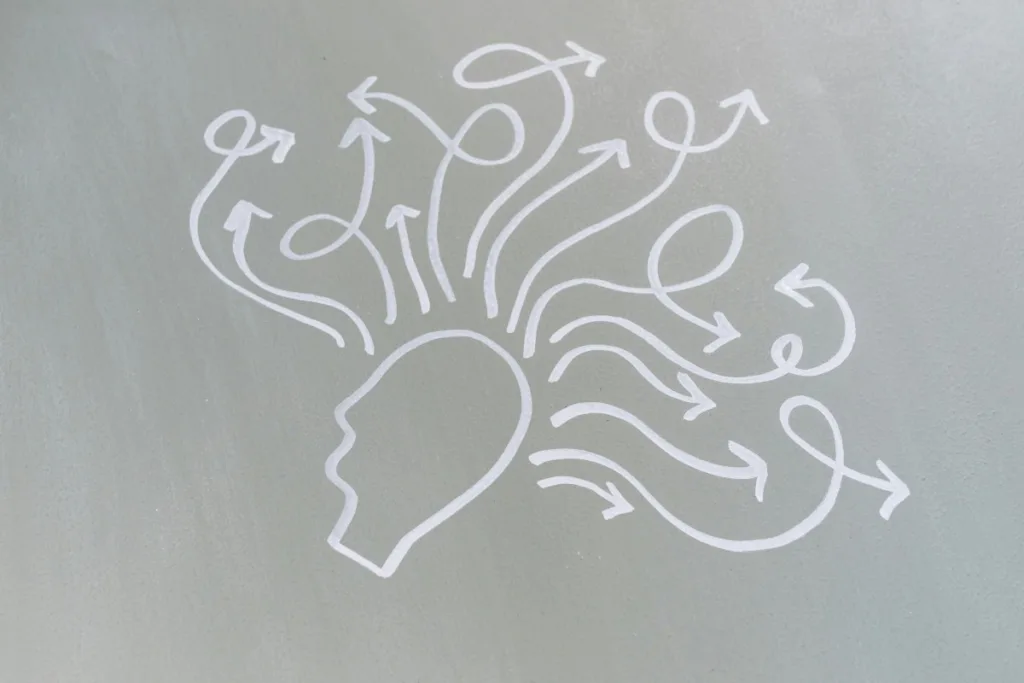
Cognitive Load Budgeting (CLB): A Weekly Practice We Use
Most guides talk about time or energy. Few talk about a mental budget. Yet cognitive science shows that juggling too many “open projects” slows your brain down the same way that too many browser tabs slow a laptop.
That’s where Cognitive Load Budgeting (CLB) comes in. Think of CLB as brain accounting. Once a week, you count your “open projects,” decide what you can actually afford, and put recovery on the books like it’s payroll.
In our experience, five active contexts is the upper limit before attention splinters. Beyond that, you’re leaking energy just by keeping tabs open.
Helpful tools:
- Free: A Notion doc or simple spreadsheet where you cap projects at five and pick your “main quest” for the week.
- Paid: Motion or Reclaim.ai, which enforces those caps by auto-scheduling focus and recovery blocks.
20-Minute Template to Set Your CLB
- List every open context. Work, side projects, personal admin—everything.
- Choose 1–3 priorities that will actually move the needle this week.
- Batch low-value admin into two fixed slots instead of letting it sprawl.
- Block two recovery breaks (walk, nap, stretch—actual recharge).
- Pre-decide what to cut if a surprise task shows up.
Do the ritual once a week and notice what changes: not just more tasks crossed off, but less static in your head.
The load feels lighter because your brain isn’t dragging every half-finished project along for the ride.
Remember, your brain’s a backpack. Jam it with every book you own, and the zipper pops, you won’t get far. CLB is picking a few essentials, sliding in what matters, and leaving room for snacks so you actually make the trip.
Future Forward: The Future of Productivity (2025+)
Imagine an AI that doesn’t just wait for your command. It notices the emails you dodge, the deep-work sprints you hit, and quietly reshuffles your calendar in real time.
That’s where we’re headed: from assistant to copilot. These tools don’t just autocomplete – they draft, summarize, prioritize, and even flag what you’re about to forget.
Reality check: early 2025 trials with developers found that some copilots slowed users by 19%, a reminder that integration still lags behind hype.
Wearables as Invisible Coaches
Wearables are evolving from step counters to ambient health mirrors.
Platforms like Whoop Coach now translate your sleep, HRV, and strain data into prompts like: “Skip the coffee—go for a walk, you’re below baseline.”
Tech giants are doubling down, too: Google calls wearables the “on-body presence” that makes personal AI truly personal.
Looking ahead to 2035, think smart patches, clothing, even car steering wheels passively gathering health signals—battery-free, seamless, and often invisible.
Workplaces Are Watching Too
Companies aren’t ignoring this. Some, like Whoop, are literally paying employees to sleep more. Others are piloting platforms that merge wearable biometrics with HR dashboards, reframing productivity as wellness plus output.
Outcomes Replace Hours
Soon, measuring productivity by time will feel as outdated as fax machines. The shift is toward impact shipped, not hours logged.
Tools like AdaptAI already blend vision, audio, and biometrics to suggest micro-breaks or generate summaries before fatigue sets in. Early pilots show gains in throughput and user satisfaction.
Why This Matters Now
- Less busywork, more brainspace. Copilots cut grunt work so you can stay on strategy.
- Data that nudges, not nags. Personalized prompts turn sleep and focus metrics into usable action.
- Outcomes over optics. Success shifts from looking busy to shipping meaningful results.
Of course, risks loom: privacy creep, fragmented attention, black-box decision-making.
The safeguard? Funnel all AI outputs back into one system (your calendar and task list) so tech amplifies focus instead of scattering it.
FAQs
What’s the single best productivity technique?
Usually, it’s the one that reduces switching—like time-blocking paired with short focus sprints. If you’re underslept, though, fix sleep first. That’s the ultimate productivity hack.
Is multitasking ever useful?
Only when tasks are low-stakes and don’t demand the same attention. Folding laundry while listening to a casual call is fine. Writing a report while answering emails? A recipe for errors.
How much sleep supports productivity best?
Most adults need 7–9 hours. Less than 7 consistently erodes performance, increases mistakes, and undercuts long-term health.
Conclusion
Productivity isn’t a mysterious trait for a select few. It’s a practice. Protect your sleep, align work with energy, and use systems that reduce switching. Add CLB once a week, and suddenly the day feels lighter. Start simple: two focus sprints, one recovery block.
Then build from there. When you’re ready, explore our mental fitness content to deepen the foundation that real productivity rests on.
